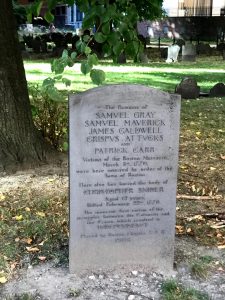A Promise for All People: Reflecting on an Afternoon at Boston’s Old State House
I have been fascinated by the history of the early Americas and United States since middle school, and dreamed of one day moving to the Boston area — since American Revolution sites are pretty hard to come by in my hometown on the central coast of California. When I arrived last autumn to begin my studies at Tufts, one of the first places I headed for was the Old State House, and it is a museum visit that has stuck with me all these months later. As I sit in California, home for a visit before it’s back to New England, I thought I would use my first post as the new History editor to reflect on that first afternoon I spent making a pilgrimage to this powerful place.
The Old State House is an impressive building. Built all the way back in 1713, it has been restored and maintained beautifully. A two-story brick structure, it manages to still catch the eye, though it is surrounded now by a swarm of much taller modern buildings.

That first day, I paused outside for a few minutes; I’ve done so every time I’ve returned. The infamous Boston Massacre (for so it was called by beloved propagandists like Paul Revere) occurred here, in the shadow of this building, on the snowy night of March 5th, 1770. An initially harmless scuffle — characterized by shouting and snowball-throwing — between Bostonians and British soldiers, many of whom were intimately acquainted because of the army’s longtime residence in the city, ended badly, and five patriots lost their lives. They are all buried together, in the Old Granary Burying Ground, a five-minute walk from the Old State House. This is another place I like to pause. Once I witnessed a father reading the victims’ names off the headstone to his little son and daughter — telling them the story of that chilly night. They listened unwaveringly.

One of the names this man read to his children was Crispus Attucks. As I walked through the Old State House that day, feeling the periodic rumble of the subway beneath me, it was this Crispus Attucks — not the Liberty Tree Flag, not John Hancock’s deep red coat, not the musket dug up at Bunker Hill — who most captured my attention.
Crispus Attucks was a sailor; he worked at sea and on the docks of the Atlantic coast; he was in Boston that night; he was, tradition tells us, the first to die. Beyond that, we don’t know much about him — except that he was part Black, part Native American. He was a man of two peoples, both of whom were severely oppressed, marginalized, and enslaved — in an era when white British colonists were crying for freedom from the “slavery” of the British crown but ignoring the rights of others. Attucks was the first to die for the cause of liberty though white patriots had no intention of offering him such a right.
On my visit to the Old State House that warm September afternoon, I climbed the stairs to the second story and was met with the special exhibit Reflecting Attucks, which examined the man’s memory, the legend he has become. Attucks is a civil rights icon and a symbol of freedom, equality, and courage, everything America should and could be. The information about the exhibit online says that Attucks’s legacy “reminds us that as long as the nation fails to realize the promise of the American Revolution for all of its people, we will always need another Attucks.”

It wasn’t what I had expected to be struck with at the Old State House in Boston. I thought I would leave thinking about John and Sam Adams, Paul Revere, John Hancock; or the night that protesting patriots tore down the building’s famous lion and unicorn statues; or the day the Declaration of Independence was read aloud from its balcony. Instead, I was thinking about our world today — the current moment of reckoning in this country, the demands of so many that we do finally realize the promise of the American Revolution for all of its people.
Every time I have returned to or reflected upon the Old State House, I think about the power of museums to make us confront the past and motivate us to shape the future. Crispus Attucks’s name reverberates through the rooms of that brick building, the wooden floors that shake with the movement of the subway, the ground outside which once was stained with his blood — and beckons us to listen, to learn, and to change.
For information on the Old State House’s hours and admission, click here. To check out the online Reflecting Attucks exhibit, click here.
Great story. love the narrative. your writing is still wonderful!!!
I don’t know who this “Lucy Wickstrom” person is, but she sounds like an absolute genius!
I like the story you wrote and know lots of people would benefit from learning from reading this. I am a part time historian you may say, have been interested in history since I was young and growing up in Connecticut and New Jersey and New York, learned a lot and seen alot. I now live in California on the coast near santa Maria and am trying to find historical places to see and explore. Wish you luck on your venture and keep them coming.